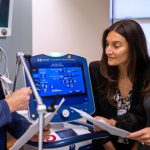Community-based lifestyle interventions promoting weight loss and physical activity to improve health have been growing in popularity nationwide since the Centers for Disease Control and Prevention announced the success of its Diabetes Prevention Program more than a decade ago.
But the main result reported for lifestyle intervention programs that take a “whole lifestyle” approach to improving health is usually weight loss. And, while weight is easy to measure and the risk factor most people have in common at the start, the number on the scale doesn’t tell the whole story.
University of Pittsburgh epidemiologists are suggesting an approach that focuses on each individual participant and their specific improvements in cardiometabolic risk factors—cholesterol, blood glucose, blood pressure, triglycerides, physical activity and waist size – beyond simply averaging all participants together when evaluating the impact of each program. The findings are published today in the April issue of The American Journal of Preventive Medicine.

Dr. Rachel G. Miller
“In general, reporting on group changes of participants in a lifestyle intervention based on weight and a few other health measures is certainly appropriate,” said lead author Dr. Rachel G. Miller, research assistant professor in epidemiology at Pitt’s School of Public Health. “But that can also make it difficult for scientists to evaluate the total extent of the improvements in health, specifically in diabetes and heart disease risk factors. When you measure group changes, you’re combining participants whose initial risk factors are normal with those whose cardiometabolic scores fall outside the norm.”
To address these concerns, Miller and her team analyzed data from two similarly designed Pitt studies that examined results from community interventions based on the Diabetes Prevention Program. Previous work from this team demonstrated that these community-based programs are both successful and highly accessible, and are now being offered in churches, community centers, workplaces, the military and other group settings.
When the researchers measured improvements for each risk factor using the group data, the results often were not statistically significant, implying the intervention wasn’t working for certain risk factors. However, when they took a more individualized approach, analyzing only the participants who started the program outside of the normal range for each given risk factor, they clearly demonstrated that the lifestyle intervention had a positive impact.
For example, when the team looked at triglyceride levels for all 71 participants in one of the programs, they didn’t find a significant improvement. But when they just focused on the 23 participants who started the program with triglyceride levels outside the normal range, not only were results significant from a statistical perspective, but the magnitude of the improvement also grew from two to 29 points.
When it comes to reducing diabetes or heart disease risk, Miller says that lifestyle interventions are a great option for everyone. Though individual differences affect how outcomes are reported, Diabetes Prevention Program-based interventions do not need to be tailored to an individual’s specific concerns to be beneficial, as they target many aspects of health – nutrition, physical activity, quality of life, peer and clinical support – at once.
“Especially compared to medication-based interventions, where each intervention can only target a single risk factor, these programs can more holistically or globally improve someone’s health,” she said.
Christine Khoury is a Ph.D. candidate in the University of Pittsburgh School of Medicine’s Center for Neuroscience. She is participating in the UPMC Science Writing Mentorship Program.









